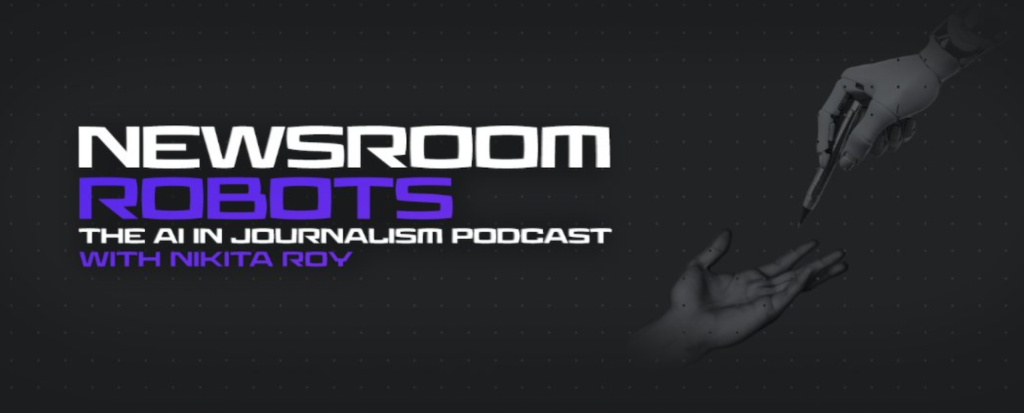As the news industry and the profession of journalism face uncertainty in the age of AI, Nikita Roy is pioneering efforts to merge traditional reporting with cutting-edge artificial intelligence, exploring innovative ways to ensure the industry’s survival and evolution.
“We stand at the brink of a groundbreaking era in journalism where artificial intelligence is unleashing unprecedented disruptions and revolutionizing the news industry,” says Roy, host of the Newsroom Robots podcast that has become a principal hub for conversations about the intersection of journalism and AI.

She also leads the AI Journalism Lab at the Craig Newmark Graduate School of Journalism at the City University of New York. In launching the program this year, Roy said: “We believe that journalists should be involved at the onset of this new technology and add their expertise to the conversation. As journalists, we should lead the way, practically and ethically.”
Meanwhile, Roy’s own digital startup, The NRI Nation, is incubating with Harvard Innovation Labs. The online news publication serves the Non-Resident Indian population worldwide.
Newsroom Robots is a podcast featuring prominent journalists, newsroom leaders and technology experts from media organizations such as Radio-Canada, Torontoverse, The Boston Globe and Associated Press. The podcast delves into in-depth discussions surrounding the future of AI and its impact on the news industry.
Roy explained at the 2024 International Journalism Festival in Perugia, Italy, that AI partially created the name for her podcast.
“There was something that came out like robot reporter or something and we were like, no, we don’t want that — we’re not going to have a robot reporter — then we were like, OK, we want the name robot and then Newsroom Robots came out of that,” said Roy.

‘It’s fundamental for us as journalists to understand how this technology works and at its core what generative AI is doing.’
— Nikita Roy, podcast host, Newsroom Robots
When ChatGPT came out in 2022, newsrooms had to rethink their thoughts about AI. Roy explained that AI has developed so much in the past two years.
“So when you’re talking about generative AI tools, which is something that really came about with ChatGPT in November 2022, and we are now in 2024 and there’s been so much development that’s happened,” said Roy. “ChatGPT-plus came out with a more foundational model called GPT-4, a more advanced model that is capable of doing way more activities.”
Roy says with the newer and paid versions of ChatGPT, you can download PDFs, chat with them, and use them to analyze data and create charts. One benefit for journalists is that they could use it to create a custom bot for themselves, get it to analyze their articles and have it take that information and turn it into a tweet.
However, not everyone has had the best experiences using AI. Roy emphasized that journalists need to understand how AI works to be able to utilize it effectively.

“It’s fundamental for us as journalists to understand how this technology works and at its core what generative AI is doing,” said Roy. “And at its core, it’s just a probability machine predicting what the next word is.”
Roy does three main things when using AI to generate a prompt. She explained how, first, you have to give the tool a persona defining “who” they are, and secondly, they need context for the prompt they are generating. Third, specific output criteria should be provided so the AI has parameters on what to generate.
‘We stand at the brink of a groundbreaking era in journalism where artificial intelligence is unleashing unprecedented disruptions and revolutionizing the news industry.’
— Nikita Roy, in the trailer of her podcast, Newsroom Robots.
At the April conference in Italy, Roy emphasized that ChatGPT is not a knowledge generator but a large language generator. This means that AI should not be used like the Google search engine, but to help you brainstorm or edit materials.
She also explained the main reason we haven’t been seeing significant use of generative AI in newsrooms is hallucinations, which are the tendency of these models to generate incorrect or misleading information that appears plausible.
“Use (AI) as a brainstorming companion,” advised Roy. “That’s what it is. It’s someone with a bunch of knowledge who’s read a bunch of stuff and can make some stuff up sometimes.”
Roy explained that while she uses AI to create her calendar, summarize articles and YouTube videos, and analyze data, not everyone needs to use it for everything.
If you are an expert in something, it might be faster and more efficient to complete many tasks without AI, but if you are working on something you’re less familiar with, AI can help.
Roy explained that she is eager to see how AI tools will be incorporated in newsrooms in the future.
“I’m really excited to learn more about how AI is being introduced and implemented in the newsroom from a readership point of view,” Roy said in her trailer for Newsroom Robots.